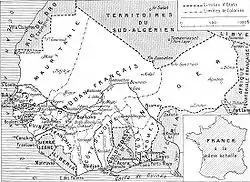
The Ivory Coast–Mali border is 599 km (372 m) in length and runs from the tripoint with Guinea in the west to the tripoint with Burkina Faso in the east.[1]
Description
The border starts in the west at the tripoint with Guinea; it then proceeds, indirectly, eastwards via a series of overland and riverine sections (rivers utilised include the Baoule, Gbolonzon, Bessin, Dougoulinfolo, Degou, Banifing, Boronikono, Babani, Bagoé, Kobani, Yaka Anka, Lofoon, Kafonrako and Danboro), before reaching the tripoint with Burkina Faso on the Léraba River.[2]
History

France had begun signing treaties with chiefs along the modern Ivorian coast in the 1840s, thereby establishing a protectorate which later became the colony of Ivory Coast in 1893.[3] As a result of the Scramble for Africa in the 1880s France had gained control the upper valley of the Niger River (roughly equivalent to the areas of modern Mali and Niger). France occupied this area in 1900; Mali (then referred to as French Sudan) was originally included, along with modern Niger and Burkina Faso, within the Upper Senegal and Niger colony and (along with Ivory Coast) became a constituent of the federal colony of French West Africa (Afrique occidentale française, abbreviated AOF).[4][3] A decree of 17 October 1899 transferred the towns of Odienné and Kong to Ivory Coast from French Sudan.[3] The precise date the boundary was drawn appears to be uncertain - it is thought to have been drawn at the time of the formal institution of French West Africa and its constituent units in the 1890s.[2]
The internal divisions of AOF underwent several changes during its existence; what are now Mali, Niger and Burkina Faso were initially united as Upper Senegal and Niger, with Niger constituting a military territory ruled from Zinder. The Niger military territory was split off in 1911, becoming a separate colony in 1922, and Mali and Upper Volta (Burkina Faso) were constituted as separate colonies in 1919.[3] During the period 1932-47 Upper Volta was abolished and its territory split out between French Sudan, Niger and Ivory Coast.[2]
As the movement for decolonisation grew in the post-Second World War era, France gradually granted more political rights and representation for their sub-Saharan African colonies, culminating in the granting of broad internal autonomy to French West Africa in 1958 within the framework of the French Community.[5] Eventually, in 1960, both Mali and Ivory Coast gained independence, and their mutual frontier became an international one between two states.[2]
Since the outbreak of conflict in northern Mali in 2012 Ivory Coast has begun strengthening security at the border in order to prevent any spill-over.[6][7]
Settlements near the border
Ivory Coast
- Sokourabo
- Tingrela
- Kanakoro
Mali
References
- ↑ CIA World Factbook – Mali, retrieved 17 January 2020
- 1 2 3 4 Brownlie, Ian (1979). African Boundaries: A Legal and Diplomatic Encyclopedia. Institute for International Affairs, Hurst and Co. pp. 371–74.
- 1 2 3 4 International Boundary Study No. 171 – Ivory Coast-Mali Boundary (PDF), 26 November 1979, retrieved 18 January 2020
- ↑ Decree 7 September 1911, rattachant le territoire militaire du Niger au gouvernement général de l'Afrique occidentale française, published in the Official Journal of the French Republic on 12 September 1911 (Online)
- ↑ Haine, Scott (2000). The History of France (1st ed.). Greenwood Press. p. 183. ISBN 0-313-30328-2.
- ↑ "Mali: Gunmen attack village near Ivory Coast border". San Diego Union Tribune. 28 June 2015. Retrieved 28 January 2020.
- ↑ "Ivory Coast reinforces border security after Mali attacks". Reuter. 1 July 2015. Retrieved 28 January 2020.